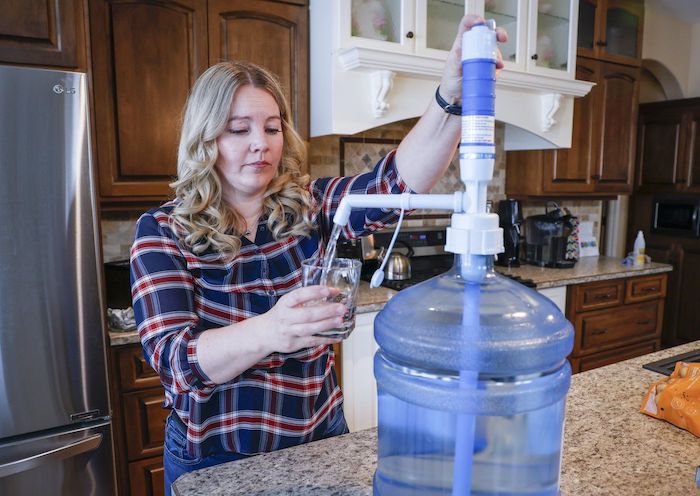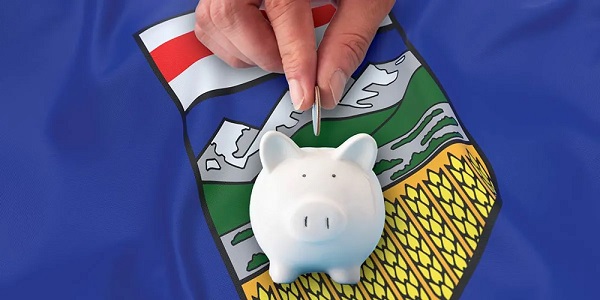Alberta
Alberta investigates Red Deer County family’s lead-contaminated water well near gravel mine

By Bob Weber
Red Deer County – Alberta Environment is investigating how a family’s water well near a gravel mine became so contaminated by lead it’s no longer drinkable.
The investigation comes as Red Deer County considers expanding mine operations that Jody Young suspects are the source of the lead she and her family may have been drinking for months.
“We have it in our blood,” said Young. “My son’s levels are actually higher than mine.”
Young, who lives just south of Red Deer near the banks of the Red Deer River, has lived within a few hundred metres of the county’s gravel mine for more than a decade.
She grew used to the slight murkiness of her once-clear well water as the mines near her central Alberta home stepped up production. Tests a few years ago showed the water was OK and she preferred the tap to a plastic bottle.
But the water kept getting worse.
“We’ve gone from just seeing it in a bathtub to being able to see it in a glass of water,” she said.
So last summer she asked Alberta Health Services to test her family’s well water. Within days, she got a call.
“They told us to immediately stop drinking our water,” she said. “We weren’t to cook with it. We were advised not even to brush our teeth with it.”
Lead — which can cause anemia, weakness, kidney and brain damage — was above levels fit for human consumption. So was aluminum.
Both metals were subsequently found in blood samples from her family.
“It was deeply concerning to learn of well water contamination in Red Deer County,” said Alberta Environment spokeswoman Carla Jones in an email. “The source of these metals is under investigation.”
On Feb. 7, Young plans to appear at a public hearing hosted by Red Deer County to oppose proposed changes to a county land-use bylaw. The changes would permit gravel mines on land virtually adjacent to her water well.
The proposed expansion site, privately owned, is also on land considered environmentally significant by provincial regulators.
“We are in full compliance with Alberta Environment on our pit,” said Dave Dittrick, Red Deer County’s assistant manager. Private operators would have to follow the same regulations, he said.
“Everything they do will have to be in compliance.”
Dittrick said although the county is co-operating with Alberta Environment, it hasn’t seen the data that prompted Alberta Health’s concern.
“We have not seen any information to substantiate these claims,” he said.
Gravel, or aggregate, mines are needed for everything from paving roads to building houses. Although they’re everywhere in Alberta, data on them is hard to find.
Mines larger than five hectares must be registered and come under provincial regulation. Mines that go below the water table or involve significant water use require a Water Act licence.
“Alberta has a robust regulatory approval process to manage environmental impacts of gravel pits,” said Alberta Environment spokesman Miguel Racin.
Smaller mines — the expansion near Young’s well would be about three hectares — are largely regulated by local land-use bylaws.
But observers say such mines are an increasing concern as Alberta continues to grow.
“It’s a problem in every county,” said Vivian Pharis, an environmentalist who has been involved in previous conflicts over such mines.
“We don’t have any good provincial regulations. The primary decision is made at the municipal level and, as soon as the zoning gets changed, then it seems Alberta Environment’s hands are tied.”
Hydrogeologist Jon Fennell, who has consulted on several mine projects, said gravel mines run the risk of exposing and releasing chemicals formerly held stable.
“If you’re opening (a mine) up and exposing things to oxygen, they can weather and oxidize and get mobilized,” he said. “Any time you disturb the earth, things change.”
While municipalities are in charge of much of the gravel mine permitting process, Fennell points out they are also heavy gravel users.
“They’re very pro-gravel in some parts of the province,” he said.
Red Deer County’s previous attempt to expand its aggregate operations near Young’s home was thrown out in 2022 by a Court of King’s Bench judge over an unfair process.
Enforcement is lax even for mines that do come under provincial rules, Fennell said. Operators may be required to monitor water levels, but not water quality.
“It’s not required,” he said. “If you don’t look, you don’t find.”
Gravel mines are necessary, said Dittrick.
“Aggregate is needed for development and development is ongoing,” he said.
Some sources may be more appropriate than others, said Fennell.
“We have to get (gravel) from somewhere. The question is, from where?”
Young wonders how long her family has been drinking lead-contaminated water. And she wonders why she has to wonder about that at all.
“I’ve had some real moments with this,” she said.
She recalls learning about some of her son’s computer searches.
“I found he was Googling about lead poisoning. He was researching potential impacts to himself.”
This report by The Canadian Press was first published Jan. 17, 2023.
Alberta
Median workers in Alberta could receive 72% more under Alberta Pension Plan compared to Canada Pension Plan

From the Fraser Institute
By Tegan Hill and Joel Emes
Moving from the CPP to a provincial pension plan would generate savings for Albertans in the form of lower contribution rates (which could be used to increase private retirement savings while receiving the same pension benefits as the CPP under the new provincial pension), finds a new study published today by the Fraser Institute, an independent, non-partisan Canadian public policy think-tank.
“Due to Alberta’s comparatively high rates of employment, higher average incomes, and younger population, Albertans would pay a lower contribution rate through a separate provincial pension plan while receiving the same benefits as under the CPP,” said Tegan Hill, director of Alberta policy at the Fraser Institute and co-author of Illustrating the Potential of an Alberta Pension Plan.
Assuming Albertans invested the savings from moving to a provincial pension plan into a private retirement account, and assuming a contribution rate of 5.85 per cent, workers earning the median income in Alberta ($53,061 in 2025) could accrue a stream of retirement payments totalling $454,741 (pre-tax)—a 71.6 per cent increase from their stream of CPP payments ($264,968).
Put differently, under the CPP, a median worker receives a total of $264,968 in retirement income over their life. If an Alberta worker saved the difference between what they pay now into the CPP and what they would pay into a new provincial plan, the income they would receive in retirement increases. If the contribution rate for the new provincial plan was 5.85 per cent—the lower of the available estimates—the increase in retirement income would total $189,773 (or an increase of 71.6 per cent).
If the contribution rate for a new Alberta pension plan was 8.21 per cent—the higher of the available estimates—a median Alberta worker would still receive an additional $64,672 in retirement income over their life, a marked increase of 24.4 per cent compared to the CPP alone.
Put differently, assuming a contribution rate of 8.21 per cent, Albertan workers earning the median income could accrue a stream of retirement payments totaling $329,640 (pre-tax) under a provincial pension plan—a 24.4 per cent increase from their stream of CPP payments.
“While the full costs and benefits of a provincial pension plan must be considered, its clear that Albertans could benefit from higher retirement payments under a provincial pension plan, compared to the CPP,” Hill said.

Illustrating the Potential of an Alberta Pension Plan
- Due to Alberta’s comparatively high rates of employment, higher average incomes, and younger population, Albertans would pay a lower contribution rate with a separate provincial pension plan, compared with the CPP, while receiving the same benefits as under the CPP.
- Put differently, moving from the CPP to a provincial pension plan would generate savings for Albertans, which could be used to increase private retirement income. This essay assesses the potential savings for Albertans of moving to a provincial pension plan. It also estimates an Albertan’s potential increase in total retirement income, if those savings were invested in a private account.
- Depending on the contribution rate used for an Alberta pension plan (APP), ranging from 5.85 to 8.2 percent, an individual earning the CPP’s yearly maximum pensionable earnings ($71,300 in 2025), would accrue a stream of retirement payments under the total APP (APP plus private retirement savings), yielding a total retirement income of between $429,524 and $584,235. This would be 22.9 to 67.1 percent higher, respectively, than their stream of CPP payments ($349,545).
- An individual earning the median income in Alberta ($53,061 in 2025), would accrue a stream of retirement payments under the total APP (APP plus private retirement savings), yielding a total retirement income of between $329,640 and $454,741, which is between 24.4 percent to 71.6 percent higher, respectively, than their stream of CPP payments ($264,968).

Joel Emes
Alberta
Alberta ban on men in women’s sports doesn’t apply to athletes from other provinces

From LifeSiteNews
Alberta’s Fairness and Safety in Sport Act bans transgender males from women’s sports within the province but cannot regulate out-of-province transgender athletes.
Alberta’s ban on gender-confused males competing in women’s sports will not apply to out-of-province athletes.
In an interview posted July 12 by the Canadian Press, Alberta Tourism and Sport Minister Andrew Boitchenko revealed that Alberta does not have the jurisdiction to regulate out-of-province, gender-confused males from competing against female athletes.
“We don’t have authority to regulate athletes from different jurisdictions,” he said in an interview.
Ministry spokeswoman Vanessa Gomez further explained that while Alberta passed legislation to protect women within their province, outside sporting organizations are bound by federal or international guidelines.
As a result, Albertan female athletes will be spared from competing against men during provincial competition but must face male competitors during inter-provincial events.
In December, Alberta passed the Fairness and Safety in Sport Act to prevent biological men who claim to be women from competing in women’s sports. The legislation will take effect on September 1 and will apply to all school boards, universities, as well as provincial sports organizations.
The move comes after studies have repeatedly revealed what almost everyone already knew was true, namely, that males have a considerable advantage over women in athletics.
Indeed, a recent study published in Sports Medicine found that a year of “transgender” hormone drugs results in “very modest changes” in the inherent strength advantages of men.
Additionally, male athletes competing in women’s sports are known to be violent, especially toward female athletes who oppose their dominance in women’s sports.
Last August, Albertan male powerlifter “Anne” Andres was suspended for six months after a slew of death threats and harassments against his female competitors.
In February, Andres ranted about why men should be able to compete in women’s competitions, calling for “the Ontario lifter” who opposes this, apparently referring to powerlifter April Hutchinson, to “die painfully.”
Interestingly, while Andres was suspended for six months for issuing death threats, Hutchinson was suspended for two years after publicly condemning him for stealing victories from women and then mocking his female competitors on social media. Her suspension was later reduced to a year.
-

 Alberta8 hours ago
Alberta8 hours agoMedian workers in Alberta could receive 72% more under Alberta Pension Plan compared to Canada Pension Plan
-

 Opinion1 day ago
Opinion1 day agoPreston Manning: Three Wise Men from the East, Again
-

 COVID-191 day ago
COVID-191 day agoTrump DOJ dismisses charges against doctor who issued fake COVID passports
-

 Uncategorized2 days ago
Uncategorized2 days agoCNN’s Shock Climate Polling Data Reinforces Trump’s Energy Agenda
-

 Addictions1 day ago
Addictions1 day agoWhy B.C.’s new witnessed dosing guidelines are built to fail
-

 Business1 day ago
Business1 day agoCarney Liberals quietly award Pfizer, Moderna nearly $400 million for new COVID shot contracts
-

 Business1 day ago
Business1 day agoMark Carney’s Fiscal Fantasy Will Bankrupt Canada
-

 Energy23 hours ago
Energy23 hours agoActivists using the courts in attempt to hijack energy policy







